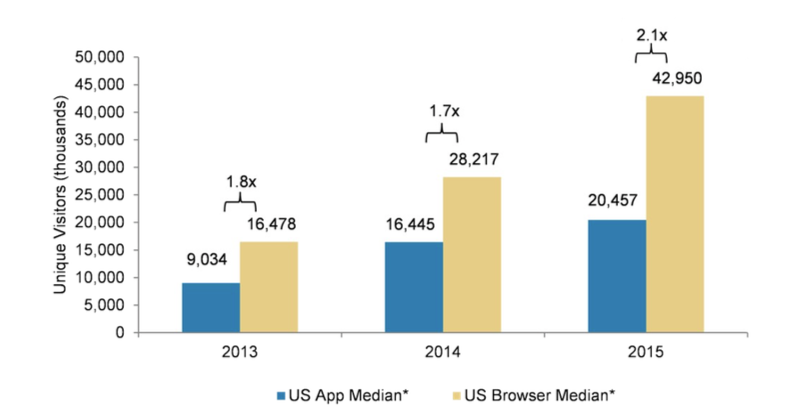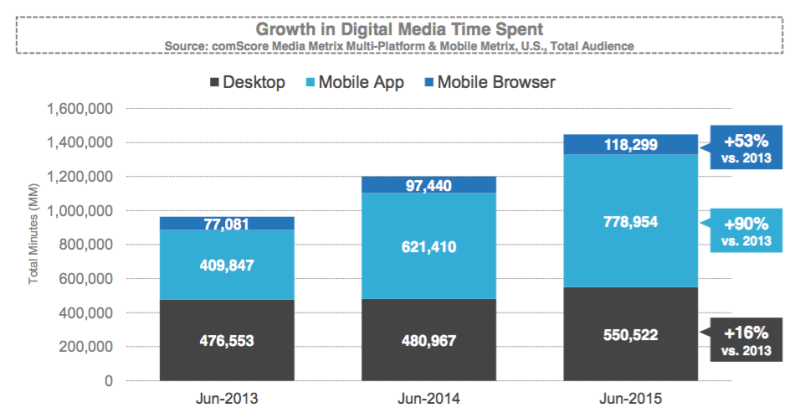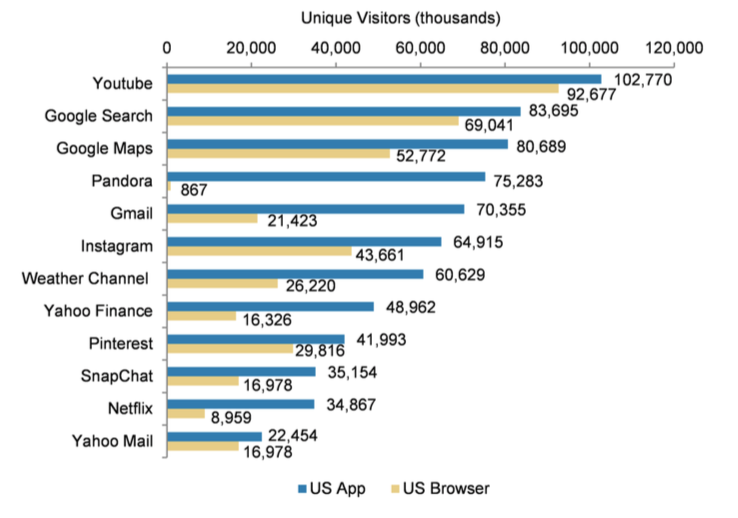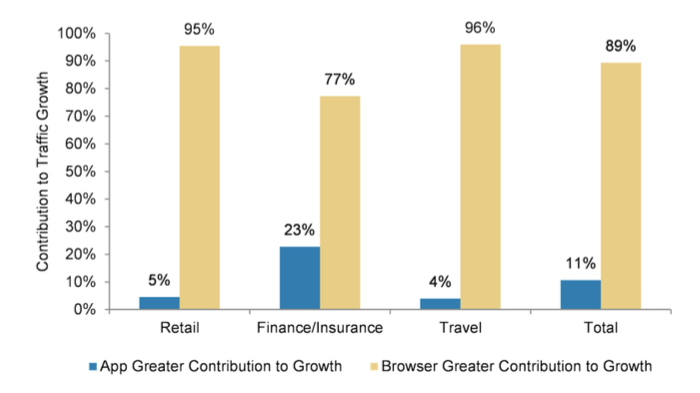Mobile browser traffic is actually twice that of mobile app traffic, according to a just-released Morgan Stanley report that rates Google’s stock as a buy. This appears to fly in the face of recent, strong, and repeated evidence that the app is winning, capturing 80-90 percent of our time on mobile.
Actually, both are right.
Using comScore data, Morgan Stanley says the web is winning:

Above: Apps versus mobile web: Web winning?
On the one hand, that’s great news for those who are facing higher and higher mobile user acquisition costs as premium in-app inventory dries up. And it’s great news for brand marketers, who are continually looking for ways to reach new customers.
But it’s also potentially confusing, given that a report released this week by comScore itself said that 87 percent of all time spent on mobile in the U.S. was spent in mobile apps. Not only are we spending almost 9 out of every 10 minutes in apps, but that number has grown 90 percent since 2013, while mobile web time has grown only 53 percent in the same period.
So comScore says the app is winning:

Both are right, of course.
The problem is terminology and the exact focus of each study. Morgan Stanley’s study is focused on unique visitors — calling it, somewhat misleadingly, “traffic” — while comScore’s report is focused on actual user time spent.
Those are vastly different measures, and it’s no shock that they present vastly different pictures of what’s happening in mobile. Mobile users spend massive numbers of hours in Subway Surfer or Game of War, blowing 80 percent of their time in just five favorite apps, while they might also visit 10 or 15 mobile web sites of companies that they’re checking out, and spend just a few moments on each. Mobile “traffic” — read unique visitors — are up on mobile web, but mobile time is also up on apps.
The questions proliferate: Why is this happening, what’s best, and what matters most? And, what should brands, companies, and media properties do?
 The answer is pretty simple: Deepest engagement for the longest period of time happens in apps, so apps matter, and they matter desperately for brands who want to connect to customers. But since, as we’ve seen in our research, apps-per-smartphone users is maxxing out at an average of 50-60, and no-one besides Robert Scoble is going to install an app for each company, service, or site he or she interacts with, your mobile web experience has to be good, and it has to be strong.
The answer is pretty simple: Deepest engagement for the longest period of time happens in apps, so apps matter, and they matter desperately for brands who want to connect to customers. But since, as we’ve seen in our research, apps-per-smartphone users is maxxing out at an average of 50-60, and no-one besides Robert Scoble is going to install an app for each company, service, or site he or she interacts with, your mobile web experience has to be good, and it has to be strong.
What you hope is that the experience with your entire company is so good, and the service or value you provide is so impressive, and the benefits to your app are so clear … that casual browsers turn into mobile app users.
Which, Morgan Stanley acknowleges, matters. Only two of the top 30 U.S. retailers drove more than 50 percent of their visits via app — Amazon and Walmart.
That’s good, the authors acknowledge:
“This is positive for these two players as over time we believe larger app audiences can lead to lower long-term customer acquisition costs, stickier customer bases, and a greater share of consumer wallets,” the report states.”
No doubt about it. Getting a much-coveted position on the 3-foot device (never more than three feet from your body) is gold for brands and gold for companies. Not only will you get a chance to serve those clients better, you’ll understand them, their habits, and their needs much better. At least, if you’re doing the right things to learn from them.
One other caveat about the Morgan Stanley report: It referenced only the top 50 mobile properties in the U.S., not the entire web/mobile space. Only 12 of those top 50 mobile properties have larger app than mobile web audiences, and those are mainly from tech companies like Google — which has four of the top 12 — and Snapchat, Pinterest, Yahoo, Netflix, and Pandora.

Interestingly, paralleling recent research we just conducted, Morgan Stanley found that YouTube is more mobile app than web. Looking at the rest of the players, it’s frankly shocking that Instagram and SnapChat have as much mobile web traffic as they do — almost half as much, in SnapChat’s case, as app traffic.
(Update: Will Critchlow, from the online marketing agency Distilled, has dug deeper into these numbers, and believes that this is completely in error — a copy-paste error likely on Morgan Stanley’s part … note that SnapChat and Yahoo Mail are exactly identical numbers in the chart above, which is very unlikely. I agree with him.)
The big takeaway here is that companies, including tech companies and media properties, need to still be aware of their mobile web experiences, especially in retail, finance, insurance, and travel, which typically see a 50 percent or higher chunk of their visits from the mobile web. At the very least, it’s the top of the funnel for a customer relationship, and a much lower-commitment step by a potential customer than the fairly big step of installing your app.

Above: 90% of the companies in travel, retail, and finance get over 50% of their visits from the mobile web
And the top of the funnel is a good place to starting nurturing visitors on the sometimes-long path to becoming dedicated repeat users or customers.
The report’s buy recommendation on Google stock? That comes from the authors’ belief that the mobile web is growing and will stay significant for some time, where, they think, Google has the advantage. The web certainly is Google’s home terrain, so I understand that to a degree, but the fact is that not only does Google do very well in mobile apps, thank you very much, the example that Facebook provided over the past few years of an internet giant pivoted so smoothly to mobile app is also evidence that Google, if indeed it is more web than app, can do something similar.
After, the search giant does own the world’s most popular — and not by a little — mobile operating system.
VentureBeat's mission is to be a digital town square for technical decision-makers to gain knowledge about transformative enterprise technology and transact. Learn More

